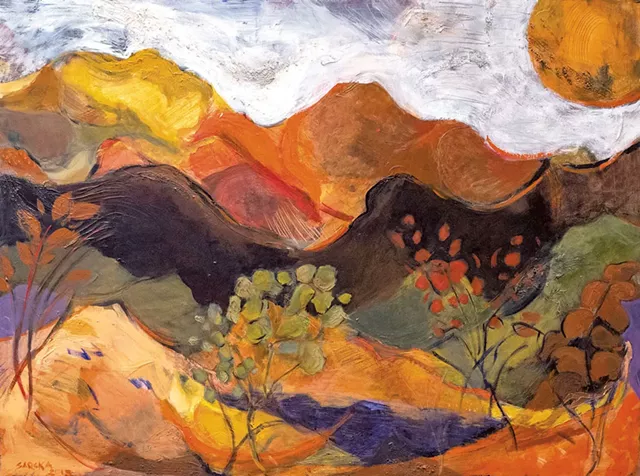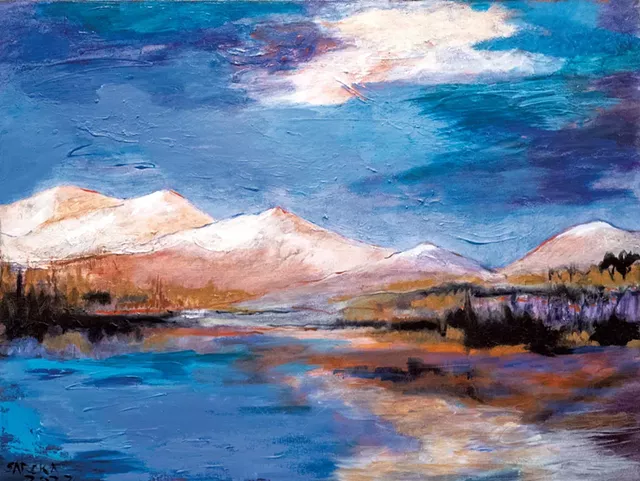In her 1961 poem “Warning,” Jenny Joseph writes, “When I am an old woman I shall wear purple / … And make up for the sobriety of my youth.” She describes an anticipated freedom: to ignore social conventions and do whatever she damn well pleases.
Montpelier painter Anne Sarcka, who turns 95 this weekend, wore purple at the April opening of “Life Reflections: Adventures in Painting,” her solo show on view through June 27 at the Vermont Supreme Court Gallery. While it seems unlikely that she would ever, as the poem says, “pick the flowers in other people’s gardens / And learn to spit,” Sarcka’s approach to painting is to follow her impulses, boldly experimenting with composition, color and technique in a way that signals she, too, is gloriously unconstrained.
The show brings together paintings made since 2007, when Sarcka, then 77, started taking classes in acrylics with Charlotte painter Cameron Davis in the University of Vermont’s continuing education program. That makes the exhibition a kind of retrospective, although it also contains works created as recently as this year. Many are on loan from friends and family, offering the public a rare chance to see them.
Subjects include landscapes, figurative pieces and abstractions. Sarcka said in a phone conversation that these aren’t separate bodies of work. “Lots of times,” she said, “I have no idea what it’s going to turn into, and then I just see what evolves as I work.” During the opening, Sarcka described how she’ll often “just put up a piece of canvas and start scribbling — and turn it — and maybe do that for a few days, or a few weeks, or a few months. And eventually, there’s something on there that really interests me.”
Those interests are made clear by the way the curators have hung the show to highlight conversation between pieces. “Water Rising,” a large abstract work from 2011, features an off-center bright white vertical stripe cutting through a darker palette, reminiscent of one of Barnett Newman’s “zips,” with round shapes anchoring it to the base of the picture plane. Next to it on the wall, “Millstone Hill Fantasy,” from the same year, foregrounds off-center white birch trees. This time, square chunks of granite near the bottom frame a deep blue quarry pool. The abstract work and the landscape are solving the same visual puzzle, each through a different lens.
Sometimes Sarcka’s puzzles are rooted in color. “Mountain Melodies” uses a palette of bright orange, ocher, peach and olive green, offset by dark blue and a bit of lavender, to depict a fauvist landscape with dancing trees. Everything is jauntily in motion. “Midnight Visions,” meanwhile, uses a similar palette to create a much darker, more foreboding sort of abstraction. There’s a near-suggestion of a body, but mostly the shapes bounce off each other, creating bright patches that jostle up against black forms.
One such echo links two works that are otherwise very different. “Ice Out,” a small painting from 2020, portrays an almost abstract landscape. Instead of the melty colors its title might suggest, vermilion mountains are reflected in a black-and-white jumble of cracking ice. Sarcka has used a pattern like stenciled tread marks throughout, creating a dynamic, violent composition.
Across the gallery, “Woman in Red and White” poses on a black chair, the lean of her shoulder and twist of her torso beautifully articulated. Her body is partially outlined with dark blue, recalling Alice Neel’s portraits. Where “Ice Out” sounds an alarm, similar colors here describe a visibly relaxed, though still energized, subject.
A strong sense of physicality runs through the exhibition. “Tallahassee Reflections” has the intensity of a pastel drawing, frenetic brushwork distinguishing between branches and the blurred surface of a pond. Many of the pieces in the show are large scale, up to 3 by 5 feet, with room for bold strokes and gestures. Sarcka said she adores working big, though it’s inconvenient: “I love getting my whole body into the painting, big arm motions and stuff.”
Both from her work and in conversation, it’s clear that Sarcka is always learning. Her family came to Vermont from Finland to labor in marble quarries in Proctor starting in the late 19th century. After her grandfather was blinded doing that work, she said, her father dropped out of school and started a job running errands for the stonemasons, eventually becoming a sculptor himself. She thinks that’s what prompted her to take sculpture at the Putney School as a teenager.
Later, Sarcka attended classes at Antioch College in Ohio and the Art Students League in New York before starting her career in social work and nonprofits, including at the Vermont Arts Council. In retirement, she spent many years learning pastels as part of the late Warren artist Billy Brauer’s longtime life drawing group. She ended up taking Davis’ acrylics class seven years running.
By email, Davis noted Sarcka’s influence on the other students: “She helped to loosen their inhibitions, encouraging through her example to just try something out, letting whatever happened signal the next move.”
A spirit of experimentation comes through clearly in the works on view. Some incorporate sand or collaged tissue paper. “Peaceful Spot,” from 2024, describes a landscape in ocher, pink and deep blue. Drippy washes of paint portray an overcast sky, while collaged cheesecloth — unique to this painting — adds depth and texture to rocks in the foreground.
Sarcka’s energy is contagious. Though a retrospective is by its nature focused on the artist, at her gallery reception Sarcka turned her attention to the audience, asking how many of us make art, or used to make art, or would maybe like to make art.
“My question to you is: What would it take for you to get started?” she said. “Just try it, and see what happens.”


